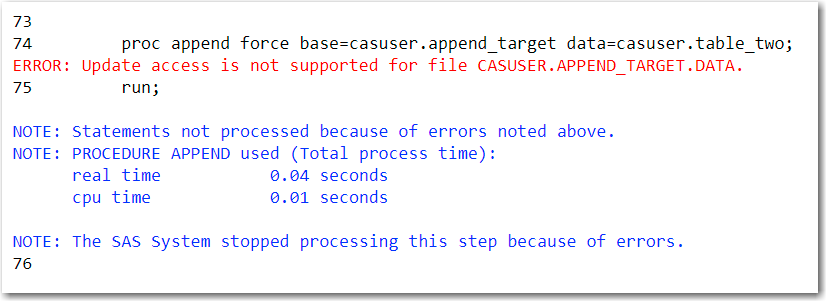Sas Append To Existing File
The sample code on the Full Code tab illustrates how to add information to the bottom of an existing file with the MOD option in the FILE statement. These sample files and code examples are provided by SAS Institute Inc. 'as is' without warranty of any kind, either express or implied, including but not limited to the implied warranties of merchantability and fitness for a particular purpose. Recipients acknowledge and agree that SAS Institute shall not be liable for any damages whatsoever arising out of their use of this material.
Hi All, I have one RTF file which has some data in it, Lets assume the file name is Test1.rtf. Now through Proc Report I have to append data from a. I'm looking for a way to append SAS data to an existing ms access file in such a way as to retain the keys that have been set up in the access file.
In addition, SAS Institute will provide no support for the materials contained herein. /. Create base file./ data null; infile datalines truncover; file 'C: Temp basefile.txt'; input fruit:$10.; put fruit; datalines; apple banana coconut; run; /. Append information to the existing file using MOD option./ data null; file 'c: Temp basefile.txt' mod; input fruit:$10.; put fruit; datalines; date elderberry fig; run; These sample files and code examples are provided by SAS Institute Inc. 'as is' without warranty of any kind, either express or implied, including but not limited to the implied warranties of merchantability and fitness for a particular purpose. Recipients acknowledge and agree that SAS Institute shall not be liable for any damages whatsoever arising out of their use of this material.
In addition, SAS Institute will provide no support for the materials contained herein.
So presumably you have one SAS dataset that you want to export and a second SAS dataset that you want to export and have it appear under the first one. Assuming the datasets have the same columns, you can do something like - data stack; set dataset1 dataset2; run; - and then output the stacked dataset instead of the two individual datasets. This will run much faster and, in your case, actually work. If you have specific questions, it would help if you edited your question with more information. – Apr 20 '16 at 15:52.
Assuming your SAS datasets are local and you are using Windows, you can use a nifty SAS macro program call exportToXL. Just google for it and it comes with instructions on how to set it up. Once you get the hang of it, it is as easy as 123.
The only caveats are, 1. You need to have PC SAS on your PC to use this program. The version is quite old and the developer did not update to handle new Excel workbooks file format i.e. It use.xls and not.xlsx. That said and if you are good with SAS programming, you can modify the program to handle.xlsx like I did.

There are several ways to do this. None of them are objectively better, though, than the answer provided by Superfluous - appending to the dataset in SAS then re-exporting. Use to perform your update. Advantage: very easy to update data. Disadvantage: barely if at all supported any longer, and requires excel to run on the same PC as SAS. Use a connection to Excel ( connect to excel).
Advantage: connecting lets you perform SQL statements, including inserts, in place. Disadvantage: has to conform to a reasonable SAS data structure, can't do formatting, can't do random inserts easily. (h/t Roger DeAngelis @ SAS-L for pointing this one out). Use the SAS Add-In to Microsoft Excel. Advantage: lets you control things from Excel more readily, much more powerful formatting options as a result.

Disadvantage: separate product has to be licensed, and is driven from Excel not SAS (though runs SAS code on a server, in stored procedures). Connect to SAS's OLEDB provider from Excel. Similar to 3, really, with a bit less control and a different (perhaps cheaper) product license.

Sas Append Data To Existing Text File
Import your data, modify it, then re-export using REPLACE. Advantage: easy to do in SAS, control over data in SAS. Disadvantage: has to conform to SAS data structure, has to write all rows out again (so could be slow). This is roughly Superfluous's suggestion.